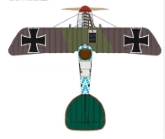I have slowly been reading through a handful of 1st hand books from World War I. I finished "Winged Warfare" by Billy Bishop, I am currently reading "Fighting the Flying Circus" by Eddie Rickenbacker, and i have also finished "The Red Knight of Germany" by Floyd Gibbons. I have noticed that the general practice was that 2-Seater (Observation, Artillery, etc.) flew alone, or in pairs, and not always with fighter escorts. Bombers were a different story, although i am not entirely sure how large their formations were. Pursuit squadrons, i am still unclear about - but i have come to see that "voluntary patrols" were of almost any number, but usually between 1 and 3.
I thought i would ask you all, more seasoned pilots, for any additional insight.






 Reply With Quote
Reply With Quote


 John as the war progressed the numbers in flights/ patrols/bombing missions increased reaching the largest numbers in 1918. Both British Squadron Flights & Jasta patrols could number from 4 to 8 in mid '18 with the Germans often combining Jastas to combat British Bombing & Strafing missions. One book I would recommend that is not extra expensive is "Aces Falling" by Peter Hart which covers the 1918 period very well.
John as the war progressed the numbers in flights/ patrols/bombing missions increased reaching the largest numbers in 1918. Both British Squadron Flights & Jasta patrols could number from 4 to 8 in mid '18 with the Germans often combining Jastas to combat British Bombing & Strafing missions. One book I would recommend that is not extra expensive is "Aces Falling" by Peter Hart which covers the 1918 period very well.







 Looking in the history books, I'm seeing rows of 10-12+ aircraft preparing to take off. I think trying to be historically accurate would cost a fortune and would result in me having to find a new squadron
Looking in the history books, I'm seeing rows of 10-12+ aircraft preparing to take off. I think trying to be historically accurate would cost a fortune and would result in me having to find a new squadron 

 mrs cc would not be happy
mrs cc would not be happy 







Bookmarks